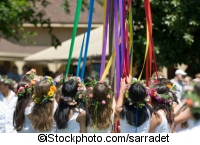Eine Weihnachtskarte zu schreiben ist in England wie in Deutschland eine jährliche Tradition. Wem und in welchem Umfang sie geschrieben werden, ist jedoch sehr unterschiedlich.
Seit wann gibt es denn Weihnachtskarten überhaupt? Die Tradition sich “frohe Weihnachten und ein gutes Neues Jahr” zu wünschen gibt es schon einige Zeit länger. Der Engländer Henry Cole war 1843 ein junger Beamter und vor allem sehr beschäftigt. Da kam ihm der Gedanke, um die ausführlichen Briefe nicht schreiben zu müssen, aber trotzdem die Segenswünsche auszusprechen, jemanden zu beauftragen eine Weihnachtskarte zu gestalten.
Dieser Jemand war John Calcott Horsley, er hat eine Karte gestalten auf der ein Familienfest in Blumenumrahmung zusehen ist. Das ganze dreigeteilt in Altarform. Darauf war “Merry Christmas and a Happy New Year to You!” zu lesen. Die Karte wurde gedruckt und von Hand eingefärbt. Verkauft wurde sie für 1 Shilling, was damals sehr teuer war. Später wurde die Auflage erhöht, so konnten die meisten Menschen es sich leisten sie zu kaufen. Verschickt wurde die Karte mit der damals ersten und noch einzigen Briefmarke der Welt, der “Penny Black”, die einen Penny wert war. [Read more…]
 England hat auch nicht religiöse Feiertage und das ist Anfang Mai der “Early May Bank Holiday”, auch “May Day” genannt, der immer am ersten Montag des Monats statt findet. An diesem Tag wird das Ende des Winters und der Anfang des Sommers gefeiert. Das Dorf oder die Stadt wird mit Blumen geschmückt und es wird so etwas ähnliches wie ein Maibaum aufgestellt und um diesen tanzen dann einige Mädchen, die auch einen Kopfschmuck aus Blumen tragen.
England hat auch nicht religiöse Feiertage und das ist Anfang Mai der “Early May Bank Holiday”, auch “May Day” genannt, der immer am ersten Montag des Monats statt findet. An diesem Tag wird das Ende des Winters und der Anfang des Sommers gefeiert. Das Dorf oder die Stadt wird mit Blumen geschmückt und es wird so etwas ähnliches wie ein Maibaum aufgestellt und um diesen tanzen dann einige Mädchen, die auch einen Kopfschmuck aus Blumen tragen.